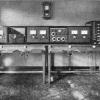Radio Luxembourg breaks with quality standards
The quality standards designed by the International Broadcasting Union were somewhat controversial, even though the organization represented the majority of broadcasting organizations in Europe. Broadcasts from commercial stations like Radio Normandy and Radio Luxembourg went against the IBU's idea of which musical genres were “high quality.”
Radio Normandy and Radio Luxembourg were private broadcasting stations that were financed by the radio industry. They specifically targeted countries beyond their borders, particularly Britain, as their customer base. They obtained revenue by selling air time for advertising or from sponsored programs. By attracting more listeners, they could more easily draw the attention of advertisers and sponsors. Consequently, they broadcast more popular entertainment music, such as jazz, operetta, and "light music." These musical choices contrasted sharply with the kind of music the IBU community chose as the ultimate expression of high-culture music.
During the interwar years, Radio Normandy and Radio Luxembourg were immensely popular. They met a demand from many listeners for accessible, relaxing programs. In particular, Radio Luxembourg was feared by the IBU community. Its transmitter was positioned in a central position in terms of Europe and could be received in most parts of the continent, and it broadcast on a long-wave frequency that had not been allocated to it in the IBU plans, which assigned the station a medium-wave frequency that would only have covered the relatively tiny territory of Luxembourg.
It was only after the war - and after it had been taken over first by the Germans, then by the Allies and used in the propaganda wars - that Radio Luxembourg received official recognition and an allocation by the ITU.
 Previous Story
Previous Story
How to cite this page
Suzanne Lommers, 'Radio Luxembourg breaks with quality standards', Inventing Europe, http://www.inventingeurope.eu/governance/radio-luxembourg-breaks-with-quality-standards
Sources
- Lommers, Suzanne. Europe - On Air : Interwar Projects for Radio Broadcasting. Amsterdam: Amsterdam University Press, 2012.
- Spohrer, Jennifer. “Ruling the Airwaves: Radio Luxembourg and the Origins of European National Broadcasting, 1929-1950." Ph.D. diss., Columbia University, 2008.
- Street, Seán. Crossing the Ether: British Public Service Radio and Commercial Competition, 1922-1945. Eastleigh: John Libbey Publishing, 2006.




















